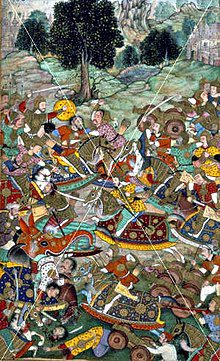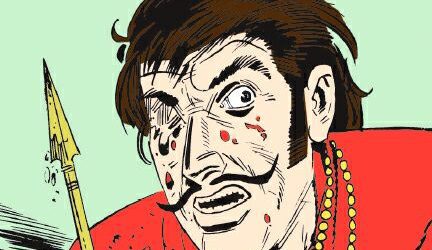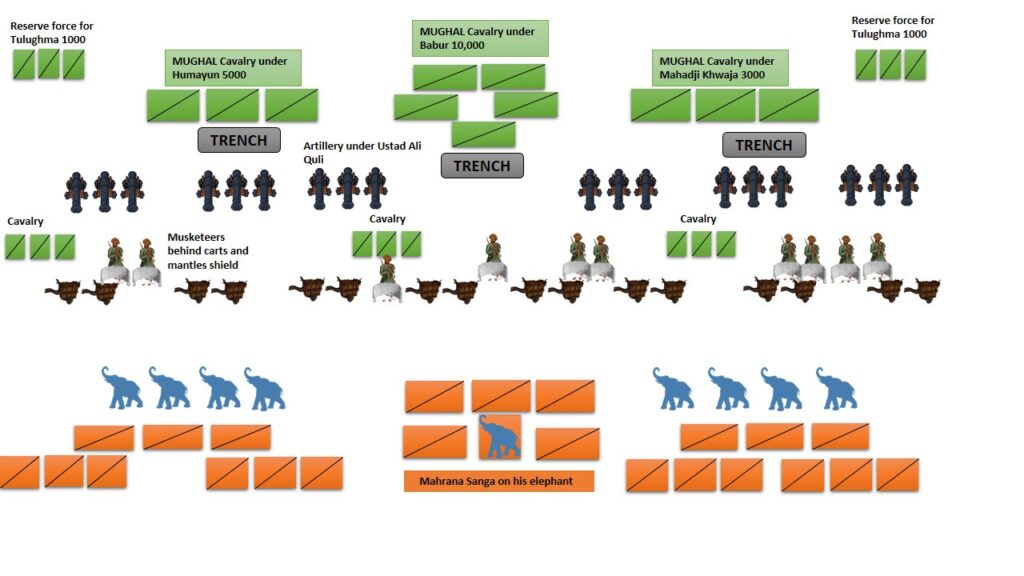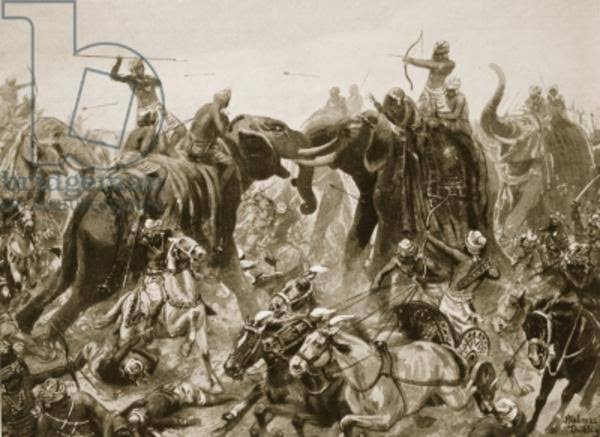Content
Background: Rana Sanga
The battle of Khanwa was the biggest battle of medieval Indian history. Many historians believe that this was the biggest battle fought by Babur and his Turko-Mongol army. The battle was a total blood bath for both sides and was fought over the course of 10 hours from morning to evening.

Image of Battle of Khanwa
Rana Sangram Singh (Rana Sanga) an astute Rajput king was born in 1482 CE. The land of Mewar is renowned for producing warriors from the times of the legendary Bappa Rawal to the great Maharana Pratap.
Maharana Sangram Singh hailed from this lineage of Kshatriyas, who don’t hesitate to slay the enemies to protect Bharat Mata’s honor. It was him, who laid the foundation of the Rajput’s unity to save Rajputana from the invaders like Lodhi’s, Gujarat Sultanate, Mughals, etc.

Rana Sanga defeated multiple sultanates during his reign and the dominion the Rajputs reached up to Banaya River in the north while in the east they subjugated Raisen, Chanderi, and Kalpi. In the southwest, they had their influence over Sirohi.
After the battle of Panipat, Sanga realized that the new invaders i.e. the Mughals will establish their authority over Delhi and won’t return to their previous country of Kabul. At this time he (Sanga) was sure that Babur and his army had to be crushed to achieve the throne of Delhi (Indraprastha) which once belonged to them (Rajput’s).
Babur
Zahiruddin Muhammad Babur was the founder of the Mughal Empire in India and modern-day Pakistan. In 1504 he captured Kabul and successfully raided several territories of India. In 1526 the Mughal army under Babur was full of mercenaries and artillery support defeated the army of Ibrahim Lodhi at the battle of Panipat.

Babur didn’t take enough time to realize that his grip on the throne of Delhi is still precarious. Moreover, the chivalrous Rajputs wanted to secure the throne of Delhi as soon as possible.
Note: The battle of Khnawa decided the fate of Delhi which was under the rule of Turk, Afghans for more than 300 years.
Before Khanwa Babur and Rana Sang met on the fields of Banaya in which the Rajputs completely routed the Mughals (about 1500). Babur declared Jihad on infidels during this battle.
Battle of Khanwa 17 March 1527
Babur prepared his strategy very well. He was aware of the fact that his Turko-Mongol army can’t match the Rajput numbers. So he relied on his main arsenal i.e. artillery, matchlocks, and their famous Tulgama tactics which were unknown to Rajput’s and the whole of India.
Battle Formation
Babur assembled his troops similar to the formation of 1st Panipat. In the vanguard, he put 1000 carts each at a distance of 40 feet apart in a straight line. Between every two carts, he placed 6 Mantlets (shields) which provide support to his musketeers. Also, there was an opening at a distance of every 60 yards in the line of carts for a cavalry attack.
In the third line, Babur placed his regular cavalry. Ustad Ali Quli was placed in the center with his strong artillery.
The cavalry was divided into three units-
Right-wing under Humayun 5000
Left wing under Mahadji Khwaja 3000
Centre under Babur 10,000
To carry out their famous Tulughma tactics 1000 troops were put on both the extreme ends.

The Hindu Rajput army of Rana Sanga was probably assembled in a traditional Rajput order having three wings left, right, and center. The undisputed Sanga commanded the central wing sitting on his elephant.
Note: Mahmud Lodi, the younger son of Sikandar Lodi, whom the Afghans had proclaimed their new sultan also joined the alliance with a contingent of Afghan horsemen with Rana Sanga.
Rana Sanga believed that his elephant unit and his cavalry will able to penetrate the Mughal vanguard.
Battle
The battle began around 9.30 AM with a ferocious charge from the Rajputs towards the Mughal center. As soon as the Rajputs came in the range of the artillery and matchlocks of Mughals they opened fire at them.
The sound of the artillery caused widespread confusion on the cavalry of the Rajput’s furthermore the artillery fire hit the Rajputs like a meteor. Heavy casualties were seen in the Hindu army. Those (Rajputs) who carried the charge were challenged by the Muskets of the Mughals. Rana Sanga and his men had never seen anything like that but this was just the first phase of the war.
Rana Sanga realized the uncertainty of the situation and ordered his troops to attack the wing instead of the center. After this right-wing of the Rajput army smashed the Mughal left with their elephants. Babur’s right-wing was also attacked at the same time.
According to Mughal chronicles band after band of infidels attacked the Mughal even when the latter was firing at them with muskets and matchlocks. Initially this tactic work for Sanga’s men but after some time the Tulugham contingents of Babur came into action and pushed the Rajputs back.
These engagements on the flanks continued for some time until the center of the Rajputs collapsed due to heavy shelling of artillery. With their center almost collapsing from the artillery and muskets Rana Sanga decided to charge for the final time around evening.

Seeing this Babur ordered his central cavalry which was placed right behind the carts opening to stop the charge of Rajput’s. The already tired and disarranged army of Rajputs were pushed back and with this, the artillery of the Mughals kept advancing for the final attack.
In the midst of this chaos the leader of the Rajputs i.e., Rana Sanga got injured and fell unconscious probably from musket bullets.
Seeing this the Rajputs decided to make a final charge while some of them decided to safely remove their leader from the battlefield to fight for another day.
At last around evening the showdown at Khanwa ended with the defeat of the Rajputs. The Hindu army fought for 10 hours in which they witnessed the fierce bombardment of artillery, muskets, and treachery.
Note: According to R.C. Majumdar the story of Silhadi betraying Rana Sanga was an invention of later historians.
Aftermath
The main cause of Rajput defeat was their disorganized army. Their leader i.e. Rana Sanga was the only person who showed real interest in securing the throne of Delhi, while his fellow warlord often fought each other.
Furthermore, the army of Babur was full of experienced mercenaries who had a deep knowledge of warfare and artillery.
Rana Sanga was full of bravery and courage but his halfhearted allies often disobeyed him.
After the battle of Khanwa, Babur adopted the title of Ghazi and secured the throne of Hindustan. At the same time, he declared Jihad on India too. Meanwhile, the valorous Rana Sanga didn’t give up and even prepared the remaining Rajputs to gather whatever they had left to crush the alien rule of Mughals.
According to Abul Fazl, Rana Sanga laid a siege on the fort of Irij which was under a Muslim ruler but he later retreated because of lack of resources and due to his injuries. At this crucial juncture, this charismatic Rajput king attained martyrdom at the age of 46.
The battle of Khanwa was the biggest battle of the 16th century that changed Indian history forever.
LIKE WHAT WE ARE DOING? DONATE TO DHARMAYUDH !
If you support what we are doing and would like to contribute to help us grow and reach more Indians to teach them more about such forgotten historic Indian Heroes and stories, please consider donating any amount. It will help us grow.

